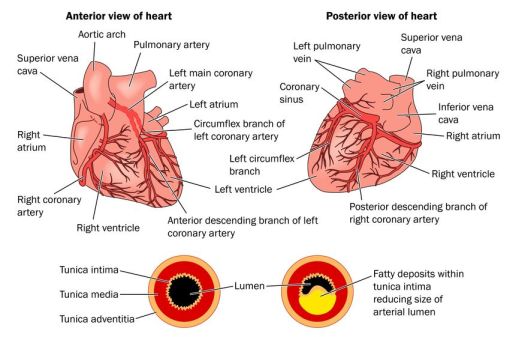Coronary arteries and the risk of heart attack
Coronary arteries are branches of aorta and their main task is to supply oxygenated blood to the heart itself. If they get clogged there is a risk of heart attack and stroke. In this post we shall describe these risk factors in more details.
Coronary artery branches
The heart is usually supplied from two coronary arteries – the right one and the left one. Both of them run in a sulcus called coronary sulcus, which actually separates heart ventricles from heart atria.
Branches of left coronary artery are as follows:
Anterior descending branch (or LAD – Left anterior descending artery) – Diagonal arteries (D1, D2, etc...) – left conus (arteriosus) artery – left atrial branches circumflex branch – left marginal artery – left posterolateral artery (present in 55% cases).
Branches of right coronary artery are as follows:
Sinoatrial node artery (SAN) - Right conus (arteriosus) artery - Right atrial branches - Right marginal artery - Posterior descending branch - Atrioventricular node branch - Right posterolateral artery (present in 45% cases).
The arteries in bold may get clogged and cause myocardial infarction.

Coronary arteries, myocardial bridges and risk of myocardial infarction
Coronary arteries usually run on the surface of the coronary sulcus and are covered by some fatty tissue. However sometimes a myocardial bridge (e.g. a small portion of the heart muscle) may grow over the coronary artery and cause its narrowing or even clogging due to compression. Smaller bridging (vincula) are normally undetectable and they usually do not cause any blood flow problems as coronary arteries are filled during myocardial relaxation (diastole).
On the other hand, larger bridges (ponticles) may cause coronary artery clogging. This mainly concerns Anterior descending branch (LAD) or Diagonal arteries.
What else increases the risk of coronary artery related heart attack?
In addition to myocardial bridges there are also some more important risk factors of coronary artery clogging. One of them is atherosclerosis, which is closely related to high cholesterol levels in blood. Too much cholesterol in blood may block auto-repairing functionality of arteries and lead to atherosclerotic plaque formation in the artery. This of course results in arterial stenosis and clogging. Also some conditions, such as diabetes mellitus, increase the risk of heart attack due to the fact that they compromise auto-repairing functionality of blood vessels and make them fragile.
| Written by: | Michal Vilímovský (EN) |
|---|---|
| Education: | Physician |
| Published: | March 12, 2013 at 10:20 AM |
| Next scheduled update: | March 12, 2015 at 10:20 AM |
Related articles
Get more articles like this in your inbox
Sign up for our daily mail and get the best evidence based health, nutrition and beauty articles on the web.






Ache in left arm that you should not ignore
Alkaline water dangers: why you should not drink it
How to Avoid Sleepiness While Studying?
23 Foods That Increase Leptin Sensitivity
Low dopamine (e.g. dopamine deficiency): causes, symptoms, diagnosis and treatment options
Swollen taste buds: the ultimate guide to causes, symptoms and treatment
Thin endometrial lining: causes, symptoms, diagnosis and treatment
Pimples inside nose: the complete guide
Holes in tonsils: definition, symptoms, treatment and prevention
How to deal with an ingrown hair cyst
Allegra vs. Zyrtec vs. Claritin
Allergy to penicillin and alternative antibiotics
How to get rid of phlegm (excessive mucus) in throat? Detailed guide to medical and home remedies, symptoms and causes
What causes stomach ache after meals?
Liver blood test results explained